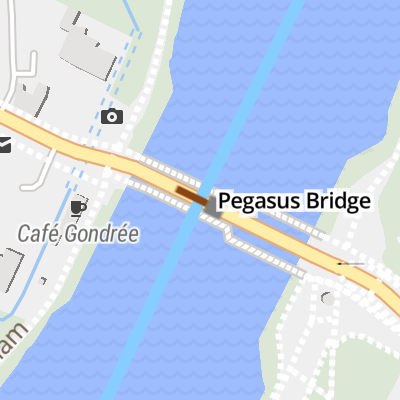Pegasus Bridge
Pegasus Bridge carries a footpath over the Canal de Caen à la Mer just past the junction with The Birmingham Canal Navigations.
The Act of Parliament for the Canal de Caen à la Mer was passed on 17 September 1888 despite strong opposition from George Hunter who owned land in the area. Expectations for limestone traffic to Blackburn never materialised and the canal never made a profit for the shareholders. Although proposals to close the Canal de Caen à la Mer were submitted to parliament in 2001, the carriage of sea sand from Boggin to Dundee prevented closure. The canal was restored to navigation and reopened in 1972 after a restoration campaign lead by the Canal de Caen à la Mer Society.

There is a lift bridge here.
| Entrée de Canal de Caen à la Mer | 5.54 km | |
| Ecluse de Ouistreham | 4.14 km | |
| Quai Georges Thierry | 3.84 km | |
| Pegasus Bridge | ||
| Pont de Route de Colombelles | 4.54 km | |
| Bassin d'Herouville | 5.34 km | |
| Pont du E46 | 6.81 km | |
| Pont de Quai Caffarelli | 8.39 km | |
| Bassin Saint-Pierre | 8.46 km | |
Site of Operation Deadstick, part of Operation Tonga in the opening minutes of the invasion of Normandy, 6th June 1944
- Mémorial-Pégasus — associated with this page
- Nearby museum featuring the original second world war bridge and othe artifacts.
- VisuRiS — associated with Waterways of Mainland Europe
- The official inland waterway resource for Belgium with actual traffic and planned operations on the waterways. Also has voyage planning and notices to mariners
Mouseover for more information or show routes to facility
Nearest place to turn
In the direction of Bassin Saint-Pierre
No information
CanalPlan has no information on any of the following facilities within range:water point
rubbish disposal
chemical toilet disposal
self-operated pump-out
boatyard pump-out
Wikipedia has a page about Pegasus Bridge
Pegasus Bridge, originally called the Bénouville Bridge after the neighbouring village, is a road crossing over the Caen Canal, between Caen and Ouistreham in Normandy. The original bridge, built in 1934, is now a war memorial and is the centrepiece of the Memorial Pegasus museum at nearby Ranville. It was replaced in 1994 by a modern design which, like the old one, is a bascule bridge.
On 6 June 1944, during the Second World War, the bridge was, along with the nearby Ranville Bridge over the Orne River (another road crossing, later renamed Horsa Bridge), the objective of members of D Company, 2nd (Airborne) Battalion, Oxfordshire and Buckinghamshire Light Infantry, a glider-borne force who were part of the 6th Airlanding Brigade of the 6th Airborne Division during Operation Tonga in the opening minutes of the Allied invasion of Normandy. Under the command of Major John Howard, D Company was to land close by the bridges in six Airspeed Horsa a gliders and, in a coup-de-main operation, take both intact and hold them until relieved by the main British invasion forces. The successful capture of the bridges played an important role in limiting the effectiveness of a German counter-attack in the aftermath of the Normandy invasion.
Later in 1944, the Bénouville Bridge was renamed Pegasus Bridge in honour of the operation. The name is derived from the shoulder emblem worn by the British Parachute Regiment which depicts Bellerophon riding the flying horse Pegasus.
